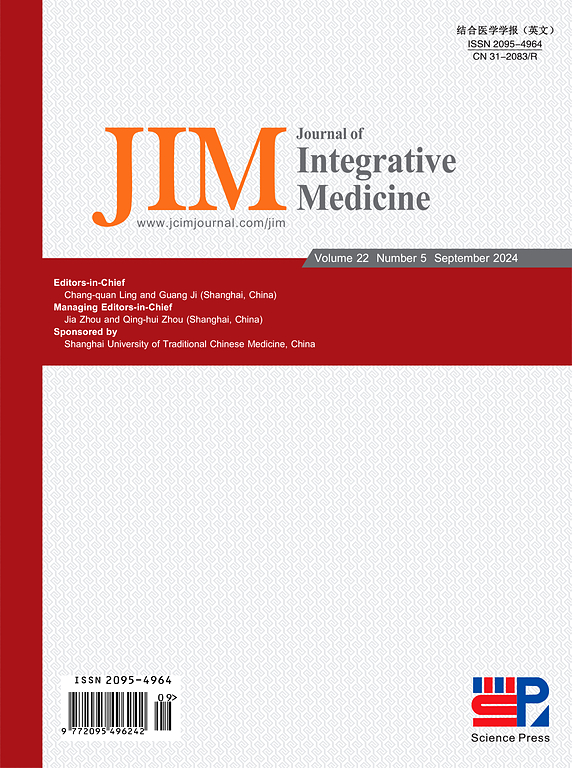黄芩素通过miR-299b-5p/HIF1-α途径抑制铁凋亡,减轻脂多糖诱导的心肌损伤。
IF 4
2区 医学
Q1 INTEGRATIVE & COMPLEMENTARY MEDICINE
引用次数: 0
摘要
目的:黄芩素具有广泛的抗炎治疗作用。本研究探讨黄芩素对败血症性心肌病(SIC)的作用及其机制。方法:对天然产物的一个小文库进行彻底筛选,包括100种不同的化合物,以确定对脂多糖(LPS)处理的H9C2心肌细胞最有效的药物。应用网络药理学方法预测黄芩素抗lps诱导心肌损伤的核心靶蛋白及其相关信号通路。结果:黄芩苷对lps暴露的H9C2心肌细胞的保护作用最强。对细胞损伤和炎症表现出剂量依赖性的抑制作用。在lps诱导的脓毒症小鼠模型中,黄芩素显示出显著的减轻lps引发的心肌缺陷、炎症反应和铁下垂的能力。网络药理分析和实验证实,缺氧诱导因子1亚单位α (HIF1-α)可能是黄芩素介导lps诱导的心肌铁下垂和损伤的关键因素。通过将lps处理心肌中的microRNA (miRNA)筛选与靶向HIF1-α的miRNA预测相结合,我们发现miR-299b-5p可能是HIF1-α的调节因子。与对照组相比,lps处理心肌中miR-299b-5p水平的降低被黄芩素治疗逆转。逆转录定量聚合酶链反应、Western blotting和双荧光素酶报告基因分析共同确定HIF1-α是心肌细胞中miR-299b-5p的靶标。结论:黄芩素在miRNA水平上缓解SIC,提示其通过调控miR-299b-5p/HIF1-α/铁ptosis通路治疗SIC的治疗潜力。本文署名:周伟,杜建军,刘海红,邓磊,马凯,肖军,张生,王纯。黄芩素通过miR-299b-5p/HIF1-α途径抑制铁凋亡,减轻脂多糖诱导的心肌损伤。集成医学[J];打印前Epub。本文章由计算机程序翻译,如有差异,请以英文原文为准。
Baicalein attenuates lipopolysaccharide-induced myocardial injury by inhibiting ferroptosis via miR-299b-5p/HIF1-α pathway
Objective
Baicalein has been reported to have wide therapeutic effects that act through its anti-inflammatory activity. This study examines the effect and mechanism of baicalein on sepsis-induced cardiomyopathy (SIC).
Methods
A thorough screening of a small library of natural products, comprising 100 diverse compounds, was conducted to identify the most effective drug against lipopolysaccharide (LPS)-treated H9C2 cardiomyocytes. The core target proteins and their associated signaling pathways involved in baicalein’s efficacy against LPS-induced myocardial injury were predicted by network pharmacology.
Results
Baicalein was identified as the most potent protective agent in LPS-exposed H9C2 cardiomyocytes. It exhibited a dose-dependent inhibitory effect on cell injury and inflammation. In the LPS-induced septic mouse model, baicalein demonstrated a significant capacity to mitigate LPS-triggered myocardial deficits, inflammatory responses, and ferroptosis. Network pharmacological analysis and experimental confirmation suggested that hypoxia-inducible factor 1 subunit α (HIF1-α) is likely to be the crucial factor in mediating the impact of baicalein against LPS-induced myocardial ferroptosis and injury. By combining microRNA (miRNA) screening in LPS-treated myocardium with miRNA prediction targeting HIF1-α, we found that miR-299b-5p may serve as a regulator of HIF1-α. The reduction in miR-299b-5p levels in LPS-treated myocardium, compared to the control group, was reversed by baicalein treatment. The reverse transcription quantitative polymerase chain reaction, Western blotting, and dual-luciferase reporter gene analyses together identified HIF1-α as the target of miR-299b-5p in cardiomyocytes.
Conclusion
Baicalein mitigates SIC at the miRNA level, suggesting the therapeutic potential of it in treating SIC through the regulation of miR-299b-5p/HIF1-α/ferroptosis pathway.
Please cite this article as: Zhou WY, Du JK, Liu HH, Deng L, Ma K, Xiao J, Zhang S, Wang CN. Baicalein attenuates lipopolysaccharide-induced myocardial injury by inhibiting ferroptosis via miR-299b-5p/HIF1-α pathway. J Integr Med. 2025; 23(5):560–575.
求助全文
通过发布文献求助,成功后即可免费获取论文全文。
去求助
来源期刊

Journal of Integrative Medicine-Jim
Medicine-Complementary and Alternative Medicine
CiteScore
9.20
自引率
4.20%
发文量
3319
期刊介绍:
The predecessor of JIM is the Journal of Chinese Integrative Medicine (Zhong Xi Yi Jie He Xue Bao). With this new, English-language publication, we are committed to make JIM an international platform for publishing high-quality papers on complementary and alternative medicine (CAM) and an open forum in which the different professions and international scholarly communities can exchange views, share research and their clinical experience, discuss CAM education, and confer about issues and problems in our various disciplines and in CAM as a whole in order to promote integrative medicine.
JIM is indexed/abstracted in: MEDLINE/PubMed, ScienceDirect, Emerging Sources Citation Index (ESCI), Scopus, Embase, Chemical Abstracts (CA), CAB Abstracts, EBSCO, WPRIM, JST China, Chinese Science Citation Database (CSCD), and China National Knowledge Infrastructure (CNKI).
JIM Editorial Office uses ThomsonReuters ScholarOne Manuscripts as submitting and review system (submission link: http://mc03.manuscriptcentral.com/jcim-en).
JIM is published bimonthly. Manuscripts submitted to JIM should be written in English. Article types include but are not limited to randomized controlled and pragmatic trials, translational and patient-centered effectiveness outcome studies, case series and reports, clinical trial protocols, preclinical and basic science studies, systematic reviews and meta-analyses, papers on methodology and CAM history or education, conference proceedings, editorials, commentaries, short communications, book reviews, and letters to the editor.
Our purpose is to publish a prestigious international journal for studies in integrative medicine. To achieve this aim, we seek to publish high-quality papers on any aspects of integrative medicine, such as acupuncture and traditional Chinese medicine, Ayurveda medicine, herbal medicine, homeopathy, nutrition, chiropractic, mind-body medicine, taichi, qigong, meditation, and any other modalities of CAM; our commitment to international scope ensures that research and progress from all regions of the world are widely covered. These ensure that articles published in JIM have the maximum exposure to the international scholarly community.
JIM can help its authors let their papers reach the widest possible range of readers, and let all those who share an interest in their research field be concerned with their study.
 求助内容:
求助内容: 应助结果提醒方式:
应助结果提醒方式:


